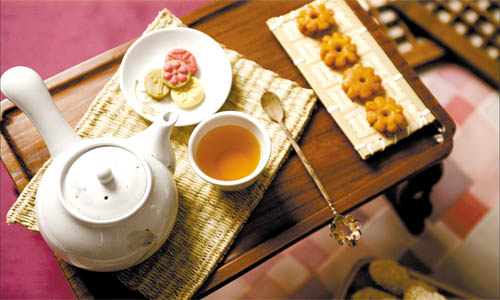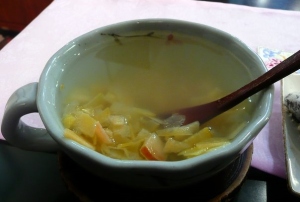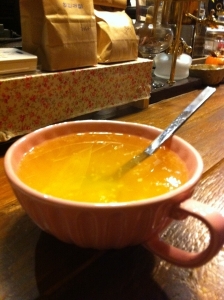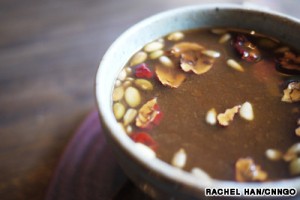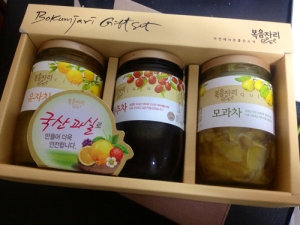Talk of tea usually revolves around China or Japan. These countries boast innumerable varieties and ancient tea-making traditions. South Korea does, too, yet you hear less if anything about them. What you also don’t hear about are their tisanes.
For a nation the size of Portugal, Korea produces a staggering number of herbal and fruit teas. Pine pollen and honey tea. Ginseng, ginger and jujube tea. Infusions made from roasted corn and Job’s Tears. Such variety makes sense when you consider the richness of their landscape: both hardwood deciduous and coniferous forests filled with fruits, roots, nuts, seeds, blossoms, leaves, herbs and berries. All make appearances in their teas. Occasionally I set aside the sencha and mao feng in order to indulge in Hanguk’s overlooked beverage pleasure dome. To spread the word, I wanted to tell other tea drinkers about Korea’s incredible tisanes and suggest Seoul teashops where travelers can try them. Seoul’s Insadong district offers the best place to start an exploration, because of the neighborhood’s central location, subway service, and the density of teashops and cafés.
As a passionate, daily tea drinker of over twenty years, I’ve tried many of Korea’s tisanes, even though I’ve not yet visited the country. I buy imported bagged and powdered versions, and I’ve made a number myself using fresh ingredients. Here are five different tisanes and a list of Seoul teashops where I’ve never been, but which do serve these teas. One day I’ll hopefully get to drink some of these in Seoul, too.
1) Five Flavors Tea
Omijacha (오미자 차), or “five flavors” tea, at Jidaebang (지대방)
(2F 196-6 Gwanhun-dong, Jongno-gu. Phone: 02-738-5379)
In Korean, cha means ‘tea.’ Although English-speakers frequently use the term ‘tea’ to describe any hot beverage, tea is technically derived from the tea plant, Camellia sinensis. A tisane is an herbal beverage containing no tea. Koreans drink green and black teas, yet the term ‘Korean tea’ usually refers to uncaffeinated, native tisanes as well.
Omijacha is brewed from the berries of the Chinese Schisandra chinensis vine. In traditional Chinese medicine, Schizandra is considered an adaptogen, like ginseng, and restorative, believed to help the heart and kidneys. It’s also said to contain all of the five distinct flavors central to Chinese medicine: salty, sour, pungent, bitter and sweet. Opened in 1982, Jidaebang is one of Insadong’s oldest teashops. They serve omijacha hot on cold days and iced during Seoul’s sweltering summers, sprinkling a few pine nuts on top, which float in an appealing contrast to the bold red tea.
2) Quince Tea
Mogwacha (모과차), or quince tea, at Yetchatjip (옛찻집)
(2F, 196-5 Gwanhun-dong, Jongno-gu. Phone: 02-722-5019, or 02-722-5332)
Mogwa is a Chinese quince which yields a tart, sweet brew reminiscent of citrus. ‘Jip’ means house in Korean, and Yetchajip translates as ‘Old Tea House.’ Insadong has been Seoul’s arts district since the Joseon Dynasty. Hidden within the neighborhood’s maze of bustling streets and alleys, Yetchajip’s building – a hanok, or “traditional house” – was built over 125 years ago, making it Insadong’s oldest teahouse. Although it’s a bit difficult to find, many people considerthis quiet, cluttered shop one of the most peaceful places in Seoul. Light is low. Fountains trickle and candles flicker. Birds chirp from a cage. Tea selection is limited (nine hot and seven cold), but ingredients are high-grade, and. The quince tea might be one of their best sellers. Tea comes with a small plate of traditional snacks, many made from glutinous, sweetened rice.
Here are a few interior photos: http://www.flickr.com/photos/68558939@N00/4245023786/
3) Citron Tea
Yujacha (유자차), or citron tea, at Star Miss Lee Café (별다방 미스리)
(Address TK. Phone: 02-739-0939)
Yuja is a tangy citrus fruit popular in Japan and China. Korean grocers sell this tea in jars, where the fruit is preserved in honey or sugar like marmalade. When people start to develop a cold or sore throat, they often spoon a bit into a mug to treat the symptoms, but nothing compares to fresh versions made in a teahouse.
Star Miss Lee Café sells yujacha and nostalgia. Located on the second floor above a convenience store, it offers games, toys, childhood comfort foods such as dosirak boxed lunches, and tea snacks such as yakgwa, a fried cookie dipped in honey. Patrons can also hang notes from nearly any surface, including an indoor tree. Here is the menu: http://www.missleecafe.com/menu.php Also, some photos: http://www.flickr.com/photos/seoulkorea/4946926893/in/photostream/
4) Jujube Tea
Daechucha (대추차), or jujube tea
Westerners might be shocked to find so much stuff floating in their tea. Blossoms, pine needles, sliced jujube fruit – with so much plant matter floating in the cup, they could mistake it as soup. It’s a problem of texture rather than taste. Western palates are accustomed to clear beverages; we’re only still getting used to tapioca pearls in tea. But the same ingredients that commonly appear in many Korean porridges and desserts also decorate teas such as daechucha.
Daechucha is believed to stimulate your appetite and help you fall asleep. You’ll commonly find jujube teas blended with ginseng, ginger and honey. Fans of herbal liquors such as Chartreuse will enjoy this classic combination. Herby and earthy without being medicinal, it carries a rich taste of earth similar to a roasted beet. Despite how that sounds, it’s surprisingly appealing.
Jujube tea is so popular that it’s sold at most teahouses, so you shouldn’t have much trouble finding a standout version.
5) Persimmon Punch
Sujeonggwa (수정과), or dessert punch, at Banjjakbanjjak Binnaneun
(6 Gwanhun-dong, Jongno-gu. Phone: 02-738-4525)
Koreans drink tisanes for health, but they also drink them for taste. Fortunately, even their healthiest teas are delicious. Sujeonggwa is a dark red brew, sweet enough that it’s called punch. Made from cinnamon, dried persimmons, ginger and peppercorn, it’s commonly garnished with pine nuts and served as dessert. Each ingredient boasts a number of healthful properties, from aiding digestion to increasing circulation. Sujeonggwa is sold commercially in cans, such as the Paldo brand’s popular 8.4oz version. As with jujube tea, sugeonggwa is so widespread that travelers who ask around should easily find a solid teahouse version. From what I can tell, though, there’s a teahouse named Banjjakbanjjak Binnaneun that brews their own sujeonggwa and sells tea serving sets. Another place to get good homemade sujeonggwa is Su Yo Il (수요일).
Perched on the second floor above the main road through Insadong, Su Yo Il means ‘Wednesday.’ Although this café is bit on the pricey side, they often throw a whole persimmon into their sujeonggwa. With such a great view from the window seats, high prices seem worthwhile.
Further info:
For more info, you can also check out the book Korean Tea Classics, written by Hong Kyeong-Hee (a native Korean, he teaches the Way of Tea at a wing of the Panyaro Institute for the Way of Tea, outside Seoul), and Steven D. Owyoung. Also, check out this this food-focused blog by a vegan named Mipa.
